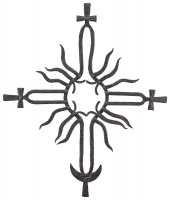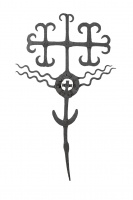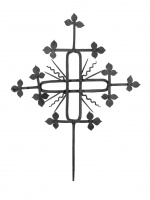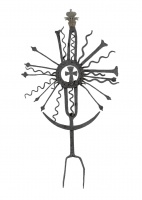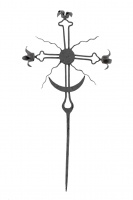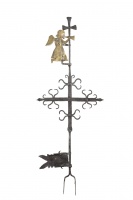
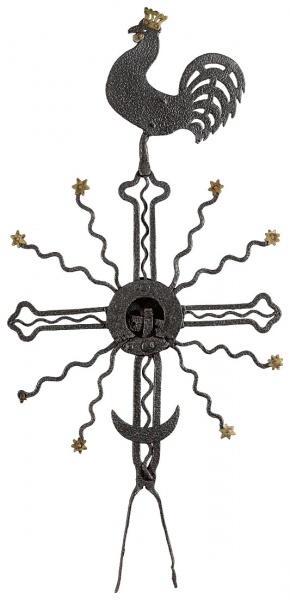

The top of a monument
| Author: |
Unknown smith |
| Created: | 19th century |
| Material: | iron |
| Technique: | wrought iron |
| Dimensions: | 73.50 × 35 cm |
Tauragnai, Utena district
Traditional small architectural objects in Lithuania were decorated at the top with wrought-iron crosses. These were mounted on the roofs of roadside shrines, and sometimes on crosses, and on gates into cemeteries or churchyards. Wrought-iron crosses also decorated religious buildings, such as churches, chapels and bell towers.
Wrought-iron crosses were made all over Lithuania, but mostly in Žemaitija and Aukštaitija, where roadside shrines were common. Often their roofs were crowned with several iron crosses.
Some had weather-vanes which rotated in the wind, usually on the lower part, but sometimes on the upper part too. Weather-vanes were usually in the form of a rectangular flag, ending in various shapes, such as a trumpeting angel, or less often a fish, a bird, or a stylised plant. Often a date was written on the flag, and
sometimes a simple decoration or a cross.
The silhouette of a cockerel makes this particular weather-vane distinctive and unusual. Few tops like this with a recognisable species of bird have survived in Lithuania. The unknown blacksmith gave the cockerel an expressive silhouette, with a gracefully curved body, a large openwork tail, a comb like a crown, and a wattle under the beak. The openwork cross contains curved rays. Between the arms are two wavy rays with starlets at the ends. Weather-vanes in the form of a cockerel have been known in Europe for a long time: they symbolise alertness, and the victory of light over darkness.
Text author Skaidrė Urbonienė
Source: Law firm Valiunas Ellex art album HEAVEN AND BEYOND (2016). Compiler Dalia Vasiliūnienė. Text authors Dalia Vasiliūnienė, Skaidrė UrbonienėExpositions: “Heaven and Beyond. Works of religious art from the collection of Rolandas Valiūnas and the law firm Valiunas Ellex“, 31 May–24 September 2016, Church Heritage Museum, Vilnius (curators Dalia Vasiliūnienė, Skaidrė Urbonienė)







